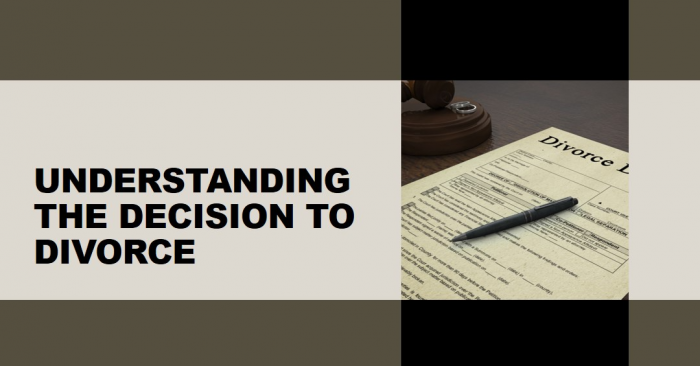Divorce is a difficult and often emotionally challenging process. When a marriage reaches the point of irretrievable breakdown, it may be necessary to pursue a divorce to bring closure and move forward in life. This comprehensive guide aims to provide you with valuable information on how to get a divorce and how to apply for divorce, ensuring that you have a clear understanding of the steps involved and the legal considerations to keep in mind throughout the process
Points to be known:
Getting a divorce is a significant and often challenging decision. If you have reached the conclusion that divorce is the best option for your situation, there are several important steps to follow.
1. Consult with an attorney:
Seek legal advice from an experienced divorce attorney who can guide you through the process and protect your rights.
2. Gather financial and legal documents:
Collect all relevant documents, including marriage certificates, financial records, property deeds, and prenuptial agreements.
3. Determine grounds for divorce:
Familiarize yourself with the grounds for divorce in your jurisdiction, such as irreconcilable differences or marital misconduct.
4. File a divorce petition:
Prepare and file a divorce petition with the appropriate court. This document outlines your reasons for seeking a divorce and your desired outcomes regarding child custody, alimony, and asset division.
5. Serve divorce papers:
Arrange for the divorce papers to be served to your spouse by a process server or law enforcement officer.
6. Negotiate and settle:
Engage in negotiation or mediation with your spouse to reach agreements on issues such as child custody, support, and property division. If an agreement cannot be reached, the court will make these decisions.
7. Finalize the divorce:
Once all issues are resolved, attend a final hearing where the judge will review the settlement and issue a divorce decree.
Divorce can be emotionally and financially challenging, so it's important to seek support from family, friends, or therapists throughout the process. Remember to prioritize self-care and focus on moving forward with your life post-divorce.

Steps:
Understanding the Decision to Divorce:
Before delving into the technical aspects of how to get a divorce, it is crucial to take the time to evaluate your decision carefully. Divorce is a significant life-altering event, and it is important to consider all alternatives and seek counseling if possible. However, if you have reached the conclusion that divorce is the only viable option, it is important to proceed with knowledge and preparedness.

Research Your Options:
Every jurisdiction has its own specific laws and requirements regarding divorce proceedings. It is essential to research and familiarize yourself with the divorce laws in your particular state or country. Understanding the legal framework will help you navigate the process more effectively.
Consult an Attorney:
Although it is possible to proceed with a divorce without legal representation, consulting with an experienced divorce attorney can provide invaluable guidance and ensure that your rights and interests are protected. An attorney can explain the legal process, help you understand your options, and provide advice tailored to your unique circumstances.

Determine Grounds for Divorce:
Different jurisdictions have different grounds for divorce, which are legally recognized reasons for ending a marriage. Common grounds for divorce include adultery, cruelty, irreconcilable differences, and separation. Understanding the grounds for divorce in your jurisdiction will help you determine the appropriate course of action and the required documentation.
Also Read: Homeowner Accepts Lowest Offer In Hot Market To Help Newly Divorced Mom
Gather Necessary Documentation:
To apply for divorce, you will typically need to gather various documents to support your case. These may include marriage certificates, birth certificates of children (if applicable), financial records, and any other relevant documentation related to assets, debts, and property ownership. Organizing and securing these documents beforehand will expedite the divorce process.
Determine the Type of Divorce:
Divorce can be pursued through different methods, depending on your situation and the level of cooperation between you and your spouse. The most common types of divorce include:
a. Uncontested Divorce: When both parties agree on all terms and are willing to cooperate, an uncontested divorce offers a simplified and relatively swift process.
b. Contested Divorce: If there are disagreements on issues such as child custody, division of assets, or spousal support, a contested divorce may be necessary. This typically involves more time, negotiation, and potential court appearances.
Mediation and Alternative Dispute Resolution:
In cases where conflicts arise during divorce proceedings, mediation or alternative dispute resolution methods can be beneficial. Mediation involves a neutral third party who assists the couple in reaching mutually acceptable agreements. This approach can help reduce hostility and legal costs, making the divorce process less adversarial.
Filing for Divorce:
To initiate the divorce process, you will need to file a petition or complaint with the appropriate court in your jurisdiction. This document outlines your reasons for divorce, desired outcomes regarding child custody and support, division of assets, and any other relevant issues. Your attorney can guide you through the preparation and filing of the necessary paperwork.

Serve Divorce Papers:
After filing the petition, it is essential to ensure that your spouse is officially served with the divorce papers. Depending on your jurisdiction, this may involve hiring a professional process server or arranging for delivery through certified mail. Proper service is crucial for the legal process to move forward.
Responding to the Divorce Petition:
If you are the respondent in a divorce case, upon receiving the divorce papers, you will typically have a specific period to respond. It is important to consult with your attorney promptly to understand your rights, responsibilities, and available options for responding to the petition.
Negotiating Settlements:
In many cases, divorcing couples can reach agreements on issues such as property division, child custody, and support through negotiation or mediation. These settlements can help avoid lengthy court battles and give you more control over the outcome. Your attorney can assist you in negotiating fair and equitable terms.

Court Proceedings and Finalizing the Divorce:
If an agreement cannot be reached, or if one party is uncooperative, the divorce may proceed to court. Both parties will present their arguments, and a judge will make decisions on contested issues. Once the court approves the final divorce settlement, the divorce becomes official.
Conclusion:
Getting a divorce can be a complex and emotionally challenging process. By understanding the steps involved and seeking professional advice when necessary, you can navigate the legal requirements more effectively. Remember to prioritize your well-being throughout the process and consider engaging the support of a therapist or counselor to help you manage the emotional aspects of divorce. While divorce is often difficult, it can also be a positive step toward a brighter future for both parties involved.












